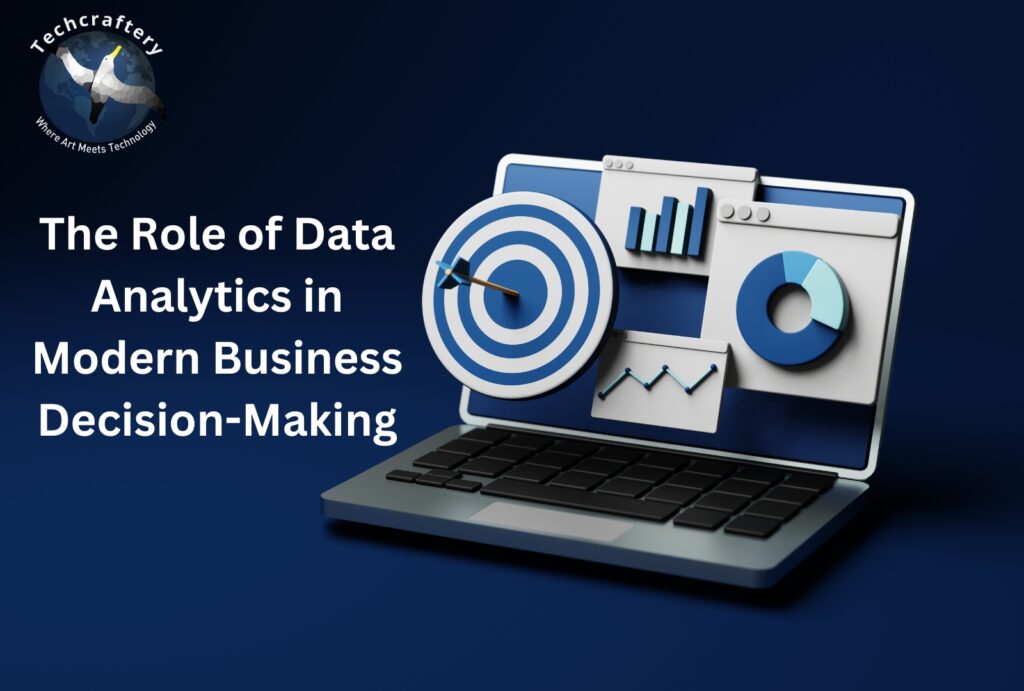The Role of Data Analytics in Modern Business Decision-Making

In today’s fast-paced business environment, data has become a crucial asset. Organizations generate vast amounts of data every day, and the ability to analyze this data effectively is essential for making informed decisions. Data analytics has emerged as a powerful tool that helps businesses understand trends, predict outcomes, and optimize processes. This article explores the role of data analytics in modern business decision-making, highlighting its benefits, techniques, challenges, and future prospects.
Understanding Data Analytics
What is Data Analytics?
Data analytics refers to the systematic computational analysis of data. It involves the collection, processing, and interpretation of large datasets to uncover patterns, correlations, and insights. Data analytics can be divided into several types:
- Descriptive Analytics: Focuses on summarizing historical data to understand what happened in the past. It provides insights into trends and performance metrics.
- Diagnostic Analytics: Examines data to determine why something happened. It involves comparing past and present data to identify anomalies and root causes.
- Predictive Analytics: Uses statistical algorithms and machine learning techniques to forecast future outcomes based on historical data. It helps businesses anticipate trends and make proactive decisions.
- Prescriptive Analytics: Suggests actions based on data analysis to achieve desired outcomes. It combines predictive analytics with optimization techniques.
The Importance of Data Analytics
In a world where data is abundant, businesses that leverage data analytics can gain a competitive edge. Here are some key reasons why data analytics is vital for modern businesses:
- Informed Decision-Making: Data analytics provides insights that enable businesses to make decisions based on facts rather than intuition.
- Improved Efficiency: By analyzing operational data, businesses can identify inefficiencies and streamline processes, reducing costs and increasing productivity.
- Enhanced Customer Understanding: Data analytics helps organizations understand customer preferences and behavior, allowing them to tailor products and services to meet customer needs.
- Risk Management: Businesses can use data analytics to identify potential risks and develop strategies to mitigate them.
- Innovation and Growth: By analyzing market trends and consumer behavior, businesses can identify new opportunities for growth and innovation.
The Role of Data Analytics in Decision-Making
1. Strategic Planning
Data analytics plays a crucial role in strategic planning. Businesses can analyze market trends, competitive landscapes, and consumer behavior to inform their long-term strategies. For example, a retail company may use sales data to identify popular products and adjust its inventory accordingly. By leveraging analytics, organizations can make data-driven decisions that align with their overall objectives.
2. Marketing and Customer Insights
Understanding customer behavior is essential for effective marketing. Data analytics allows businesses to segment their audience, analyze customer preferences, and create targeted marketing campaigns. For instance, an e-commerce company can analyze website traffic and purchase patterns to determine which products to promote. By utilizing customer data, organizations can enhance their marketing efforts and improve customer engagement.
3. Financial Management
Data analytics is invaluable for financial decision-making. Businesses can analyze financial data to identify trends in revenue, expenses, and profitability. This information helps organizations create accurate budgets, forecast future financial performance, and make informed investment decisions. For example, a company may use historical data to assess the potential return on investment for a new project.
4. Supply Chain Optimization
Data analytics plays a vital role in optimizing supply chains. Businesses can analyze data related to inventory levels, supplier performance, and demand forecasts to enhance efficiency. For instance, a manufacturing company can use analytics to predict demand fluctuations and adjust production schedules accordingly. By leveraging data, organizations can reduce costs, minimize waste, and improve overall supply chain performance.
5. Human Resources Management
Data analytics is transforming human resources management. Organizations can analyze employee data to identify trends in recruitment, retention, and performance. For example, by analyzing employee turnover rates, HR departments can identify factors contributing to attrition and develop strategies to improve employee satisfaction. This data-driven approach helps organizations build a more effective workforce.
6. Risk Management and Compliance
In today’s complex business environment, risk management is crucial. Data analytics enables organizations to identify potential risks and develop strategies to mitigate them. For example, financial institutions can use analytics to detect fraudulent transactions in real-time. Additionally, businesses can analyze compliance data to ensure they adhere to regulations and avoid costly penalties.
Techniques Used in Data Analytics
Data analytics involves various techniques and tools to extract insights from data. Some common techniques include:
1. Data Mining
Data mining involves discovering patterns and relationships in large datasets. It uses statistical techniques and algorithms to identify trends, outliers, and correlations. Businesses can use data mining to uncover valuable insights that inform decision-making.
2. Machine Learning
Machine learning is a subset of artificial intelligence that enables computers to learn from data without being explicitly programmed. Businesses can use machine learning algorithms to make predictions and automate decision-making processes. For example, e-commerce companies can use machine learning to recommend products based on customer behavior.
3. Predictive Modeling
Predictive modeling involves using historical data to create models that forecast future outcomes. Organizations can use predictive models to anticipate customer behavior, sales trends, and market changes. This technique is particularly useful for businesses looking to make informed decisions about resource allocation and inventory management.
4. Data Visualization
Data visualization tools help organizations present complex data in a visually appealing and understandable format. By using charts, graphs, and dashboards, businesses can easily interpret data and communicate insights to stakeholders. Effective data visualization enhances decision-making by making data more accessible.
Challenges in Data Analytics
While data analytics offers numerous benefits, businesses also face challenges in implementing effective data-driven decision-making. Some common challenges include:
1. Data Quality
The accuracy and quality of data are crucial for reliable analytics. Poor-quality data can lead to incorrect insights and decisions. Businesses must invest in data cleaning and validation processes to ensure the integrity of their data.
2. Data Privacy and Security
As organizations collect and analyze vast amounts of data, ensuring data privacy and security becomes a critical concern. Businesses must comply with regulations such as GDPR and CCPA to protect customer data and maintain trust.
3. Integration of Data Sources
Many organizations struggle to integrate data from various sources, such as sales, marketing, and finance. A lack of integration can lead to data silos, making it difficult to gain a comprehensive view of the business. Implementing effective data integration strategies is essential for successful analytics.
4. Skill Gap
Data analytics requires specialized skills and expertise. Many organizations face a shortage of qualified data analysts and data scientists. Investing in training and development programs can help bridge this skill gap and empower employees to leverage data effectively.
5. Resistance to Change
Implementing data-driven decision-making may encounter resistance from employees accustomed to traditional decision-making processes. Organizations must foster a culture of data-driven thinking and provide training to encourage acceptance of analytics.
The Future of Data Analytics in Business
The role of data analytics in business decision-making is expected to grow in the coming years. As technology advances, organizations will have access to more sophisticated analytics tools and techniques. Here are some trends shaping the future of data analytics:
1. Increased Automation
Automation in data analytics will enable organizations to process data more efficiently and make real-time decisions. As artificial intelligence and machine learning technologies continue to evolve, businesses can expect automated analytics processes to become more prevalent.
2. Real-Time Analytics
The demand for real-time analytics is increasing as organizations seek to make quick, informed decisions. Real-time data processing allows businesses to respond to changes in the market and customer behavior instantly.
3. Enhanced Data Visualization
As data becomes more complex, advanced data visualization techniques will be essential for effective communication of insights. Interactive dashboards and visual analytics tools will help stakeholders understand data trends more easily.
4. Greater Emphasis on Data Ethics
With growing concerns about data privacy and ethics, organizations will need to prioritize responsible data usage. Developing ethical frameworks for data collection and analysis will be critical to maintaining customer trust.
5. Integration of IoT and Big Data
The Internet of Things (IoT) will continue to generate massive amounts of data. Organizations that effectively integrate IoT data with traditional data sources will gain deeper insights and improve decision-making processes.










